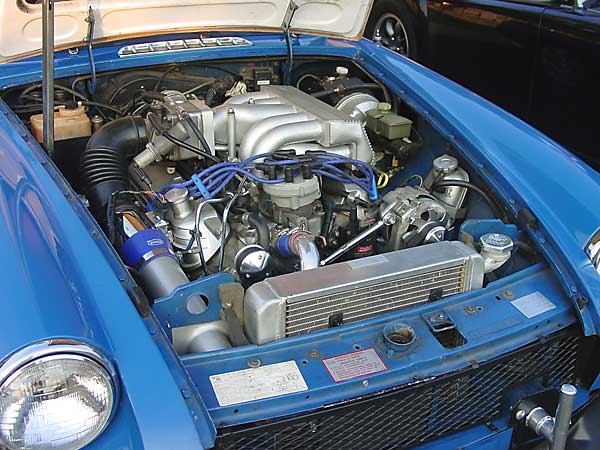
Ford 5.0L EFI Installation in an MGB
as published in British V8 Newsletter, Volume XIV Issue 3, December 2006by: Kelly Stevenson
If you're interested in installing an "electronically fuel-injected" (EFI) small block Ford V8 engine in an MGB, the first decision you'll make is probably whether to start with a complete donor car, a salvage yard engine, or an already built "crate" engine. In deciding between potential donor cars, you'll probably focus on '88-'95 Ford Mustangs, Ford Explorers and Mercury Mountaineers.
Many companies build (or remanufacture) Ford engines and sell them as crate engines. Ford Racing also has crate motors for sale. Horsepower ratings on crate engines appear to be a marketing fiction. At best, they assume optimized conditions. Generally the Mustang guys experience only about 260 rear wheel horsepower from their "345hp" rated Crate engines. Furthermore, many crate engines are sold in "long block" form, which means they don't include the fuel injection system. This article is specifically concerned with OEM EFI.
In comparing Ford-OEM EFI systems, one of the first things to note is that Ford used
two different sensor technologies to measure the amount of air entering the engine.
The "engine control module" (ECM) must know how much air is entering so that it can
provide the appropriate matching amount of fuel. Furthermore, the fuel map is
programmed to be different for cars with different specifications. (For example,
manual transmission cars may typically be programmed to idle at a slightly higher
speed than automatic transmission cars.)
The two basic sensor technologies to choose between are "speed density" and "mass air". The speed density system came first (generally around model years '85-'88), and it's adequate. Speed density systems rely heavily on manifold air pressure (MAP) sensors as a further input to the ECM in order to estimate engine load. Mass air systems (from about model years '89-'93) use a hot-wire sensor to actually measure the air flow entering the throttle body. (Passing air cools the element, which changes its electrical resistance.) Instead of a MAP sensor, they use a barometric air pressure (BAP) sensor. They also use two oxygen sensors, an air charge temperature (ACT) sensor, an engine coolant temperature (ECT) sensor, and a throttle position (TPS) sensor. Don't let all these sensors intimidate you! Their electrical connections are all different so they can't be crossed up. The two important things you will want to note are: (1) that none of the electronic parts of speed density systems are interchangable with the later mass air system parts, and (2) the mass air systems are much more "tune-able". In fact, the mass air systems are preferred because they're actually self tuning: their ECM has the ability to modify or "learn" changes as they occur and to adapt to them. (For example, the mass-air ECM can adapt better to changes in altitude or fuel quality.)
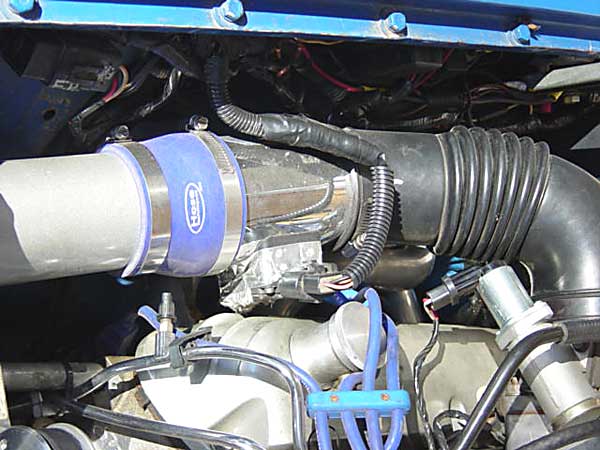
MAF sensor (PMAS brand) and cold air intake tube.
The ECM that Ford used on their mass air sensor EFI systems is known as an "EEC-IV" module. (The acronym stands for "Ford Electronic Engine Control version Four".) All EEC-IV ECM's are NOT the same. The programming is different, based on vehicle specs.
If you start with a donor car, the ECM, the main wiring harness, auxiliary wiring, and all the various and sundry small parts needed are all included! The ECM that came with my donor 1993 Mustang LX is an "A9L" EEC-IV, and I have been happy with its programming.
If the vehicle wiring is damaged or missing, purchase Ford factory replacement harnesses. (Note: part number M12071-C302 is the main engine harness for a '93 Mustang LX). You can also purchase a mass air harness package complete with sensors. (For more information on wiring, the Mustang online bulletin boards are a valuable resource. Also, the Ford Fuel Injection Manual is ISM# 12071-302 and is strongly recommended. You can order a printed copy from Ford, or download a copy from various online sources.)
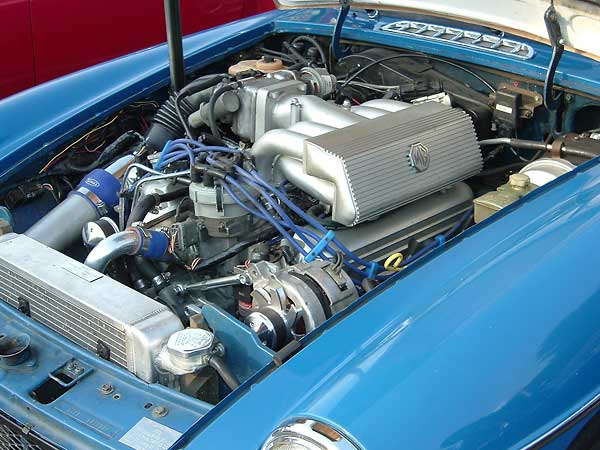
In addition to the main engine wiring harness, there are usually three smaller harnesses: one for the fuel injectors, one for the alternator, and one for the "heated exhaust gas oxygen" (HEGO) sensor. If you have a donor car, these should all be there.
We removed tape from the main Ford harness and relocated the coil connector. The coil is now mounted to the front of the left head. The HEGO connector, positive power wires (solenoid) & ECM grounds are all on the passenger-side of the car to ease connection to the MGB harness. We chose to plug the Ford temperature sender hole and drill the Ford thermostat housing water outlet for mounting an MGB sender. The MGB sender is an odd size (5/8"X 18). This change required that the temperature wire be removed from the injector harness and routed up the right side of the lower manifold.
We removed the MGB front fan relay and stripped the white & brown wires out since they are needed to power the Ford system. (White is "ignition switched power" and brown is "battery power".) The start or "crank" wire came from the OEM MGB starter relay and connects to the big Ford relay solenoid. The dedicated ground cable from the battery also mounts to the ECM ground just below the Ford relay. (Note: reliable grounds tend to be extremely important on an EFI engine!)
The MGB ignition light is connected to the Ford wire that performs the same function (noted in the wiring manual) so the dash charging light functions also.
We made a "check engine" light from an orange LED (Speedway Motors 911-31050-orange). This was mounted in the radio console on the left-hand side (visible to driver only).
We chose a modified "March Performance" pulley system to drive the alternator and water pump. The alternator was moved to the driver-side of the engine bay, and its top mounting ear was cut and re-welded with the housing clocked to allow maximum space for coil and valve cover. (A local alternator repair shop handled this modification.)
We chose to mount the Ford ECM in the recess behind the passenger-side front tire
(covered by the bolted-in "splash panel"). We made a sheet metal enclosure, that's
open at the bottom, to further protect the ECM. Be sure to reverse the mounting
bracket to the outside wall since the original mounted on the inside of the car. This
will allow the wiring to enter from the front. The Ford EFI Manual gives the procedure
for cutting the oblong hole to fit the grommet on the main wiring harness. This manual
is available online, or comes with the OEM replacement wiring harness.
The Ford manual further details the color codes of wires that need connection to the MGB wiring. On the transmission, the wiring needs to be connected to the "vehicle speed sensor" (VSS) and reverse-light switch, and the neutral safety switch. The VSS is hooked to the corresponding wires running to the ECM while the back-up-light switch is wired direct to the MGB wiring for the same circuit. (The neutral switch is not needed for operation, but will cause the ECM to record code "67" every time you pull codes from ECM.)
The "barometric air pressure" (BAP) sensor easily mounts just to the left of the heater housing. The main harnesses are routed behind the washer bracket.
The gas vapor canister and purge valve are mounted just behind the OEM washer reservoir bracket.
What fuel tank modifications were required for EFI? Modern EFI systems incorporate
a high pressure supply line and also a lower pressure return line that takes excess fuel back
to the fuel tank. We decided to use the original (late-model) MGB fuel level sender's integral
fuel pick-up tube for "return". To make this work out, we modified the pick-up so that it
turned away from the tank's sump to eliminate cavitation. With the fuel tank removed from the
car, we drilled a hole in the passenger-side bottom corner of the tank (i.e. under the filler
spout) and we bent a 3/8" steel line so that it laid in the lowest part of the sump with a
filter sock attached. (Note: with the fuel-lever sender removed we could see what we were
doing inside the tank.) We fabricated a flanged plug with internal pipe thread to mount a
barbed 3/8" fitting outside and we mounted the steel 3/8" line to the inside of this plug.
We then silver-soldered the 3/8" line into the plug and drilled a hole adequate to slip the
plug, line & filter into the tank. The flanged plug & line was silver soldered to the tank
and is leak free.
The two basic sensor technologies to choose between are "speed density" and "mass air". The speed density system came first (generally around model years '85-'88), and it's adequate. Speed density systems rely heavily on manifold air pressure (MAP) sensors as a further input to the ECM in order to estimate engine load. Mass air systems (from about model years '89-'93) use a hot-wire sensor to actually measure the air flow entering the throttle body. (Passing air cools the element, which changes its electrical resistance.) Instead of a MAP sensor, they use a barometric air pressure (BAP) sensor. They also use two oxygen sensors, an air charge temperature (ACT) sensor, an engine coolant temperature (ECT) sensor, and a throttle position (TPS) sensor. Don't let all these sensors intimidate you! Their electrical connections are all different so they can't be crossed up. The two important things you will want to note are: (1) that none of the electronic parts of speed density systems are interchangable with the later mass air system parts, and (2) the mass air systems are much more "tune-able". In fact, the mass air systems are preferred because they're actually self tuning: their ECM has the ability to modify or "learn" changes as they occur and to adapt to them. (For example, the mass-air ECM can adapt better to changes in altitude or fuel quality.)

MAF sensor (PMAS brand) and cold air intake tube.
The ECM that Ford used on their mass air sensor EFI systems is known as an "EEC-IV" module. (The acronym stands for "Ford Electronic Engine Control version Four".) All EEC-IV ECM's are NOT the same. The programming is different, based on vehicle specs.
If you start with a donor car, the ECM, the main wiring harness, auxiliary wiring, and all the various and sundry small parts needed are all included! The ECM that came with my donor 1993 Mustang LX is an "A9L" EEC-IV, and I have been happy with its programming.
If the vehicle wiring is damaged or missing, purchase Ford factory replacement harnesses. (Note: part number M12071-C302 is the main engine harness for a '93 Mustang LX). You can also purchase a mass air harness package complete with sensors. (For more information on wiring, the Mustang online bulletin boards are a valuable resource. Also, the Ford Fuel Injection Manual is ISM# 12071-302 and is strongly recommended. You can order a printed copy from Ford, or download a copy from various online sources.)

In addition to the main engine wiring harness, there are usually three smaller harnesses: one for the fuel injectors, one for the alternator, and one for the "heated exhaust gas oxygen" (HEGO) sensor. If you have a donor car, these should all be there.
We removed tape from the main Ford harness and relocated the coil connector. The coil is now mounted to the front of the left head. The HEGO connector, positive power wires (solenoid) & ECM grounds are all on the passenger-side of the car to ease connection to the MGB harness. We chose to plug the Ford temperature sender hole and drill the Ford thermostat housing water outlet for mounting an MGB sender. The MGB sender is an odd size (5/8"X 18). This change required that the temperature wire be removed from the injector harness and routed up the right side of the lower manifold.
We removed the MGB front fan relay and stripped the white & brown wires out since they are needed to power the Ford system. (White is "ignition switched power" and brown is "battery power".) The start or "crank" wire came from the OEM MGB starter relay and connects to the big Ford relay solenoid. The dedicated ground cable from the battery also mounts to the ECM ground just below the Ford relay. (Note: reliable grounds tend to be extremely important on an EFI engine!)
The MGB ignition light is connected to the Ford wire that performs the same function (noted in the wiring manual) so the dash charging light functions also.
We made a "check engine" light from an orange LED (Speedway Motors 911-31050-orange). This was mounted in the radio console on the left-hand side (visible to driver only).
We chose a modified "March Performance" pulley system to drive the alternator and water pump. The alternator was moved to the driver-side of the engine bay, and its top mounting ear was cut and re-welded with the housing clocked to allow maximum space for coil and valve cover. (A local alternator repair shop handled this modification.)
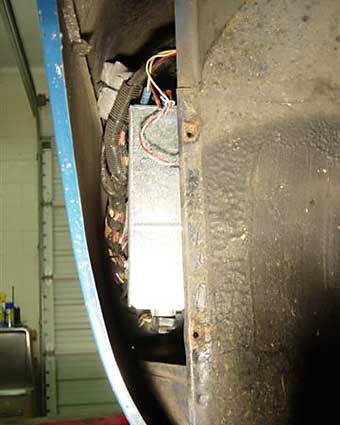 |
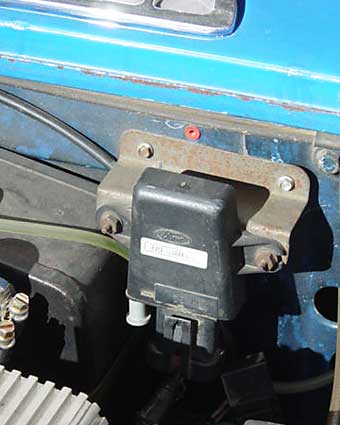 |
|
ECM, mounted behind passenger-side wheel splash panel |
BAP sensor near driver-side hood hinge |
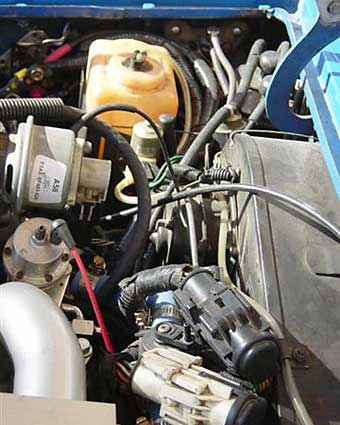 |
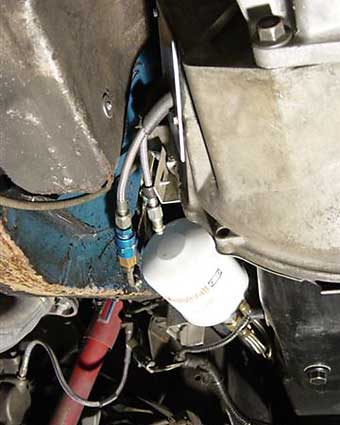 |
|
Engine harness connectors |
Remote oil filter at left rear and HTOB lines |
|
Enjoying this article? Our magazine is funded through the generous support of readers like you! To contribute to our operating budget, please click here and follow the instructions. (Suggested contribution is twenty bucks per year. Feel free to give more!) |
The Ford manual further details the color codes of wires that need connection to the MGB wiring. On the transmission, the wiring needs to be connected to the "vehicle speed sensor" (VSS) and reverse-light switch, and the neutral safety switch. The VSS is hooked to the corresponding wires running to the ECM while the back-up-light switch is wired direct to the MGB wiring for the same circuit. (The neutral switch is not needed for operation, but will cause the ECM to record code "67" every time you pull codes from ECM.)
The "barometric air pressure" (BAP) sensor easily mounts just to the left of the heater housing. The main harnesses are routed behind the washer bracket.
The gas vapor canister and purge valve are mounted just behind the OEM washer reservoir bracket.
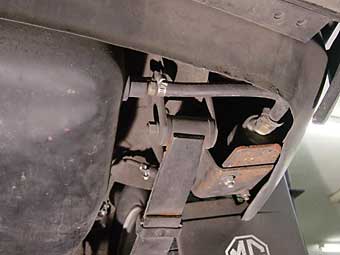 |
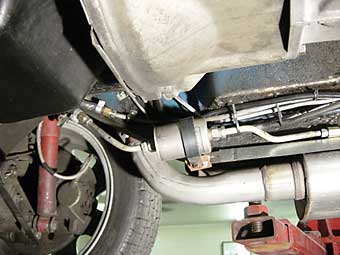 |
|
Driver-side of fuel tank, and fuel pump mounting |
Fuel filter & EFI line connections to engine & return line to old MGB line |
On our installation, most of the supply (or "pressure side") fuel line is 5/16" steel tubing
(from Summit), but I would suggest you try aluminum for ease of fabrication. The one place
where we used 3/8" steel line was in the immediate vicinity of the fuel filter. The 3/8"
steel fuel line was sourced from a Chevrolet truck in the salvage yard. We preferred the
Chevrolet truck fuel filter's threaded nuts (for 3/8" line) over slip-lock connectors.
Our trick was to slip the end of 5/16" steel line inside short pieces of 3/8" line, and
then silver solder them together. (3/8" line can easily be double flared for any unions.)
We used a little flex line too: from the fuel tank to the pump. Regular fuel hose isn't up
to the job, so make sure to get "EFI" rated hose. The OEM fuel rails were used along with the
OEM fittings. (They required some bending to re-use). That's it for the supply side! As
mentioned above, the MGB's original gas line was used for the return side.
Fuel pump: fabricated mounting bracket for MSD Electric Pump part number 2225 ($95 on eBay). This pump is plumbed for 3/8" inlet and 5/16" outlet. The mount was welded to the right rear factory tow bracket just behind the tire up inside the quarter-panel. The pump was bolted to another bracket to allow it to be removed easily and serviced if needed. It was powered from a relay in the trunk activated by the MGB fuel pump power wire. A separate fused wire runs to the battery and hooks directly to the relay. The MGB under-dash "upset switch" was eliminated and a Mustang inertia switch was wired-in instead.
Induction: a "CAI" (cold air intake) was made from a 3" diameter piece of tubing from a muffler shop. The tubing is mated to K&N Filter (part number RF1030, approximately $75). It was routed through the passenger-side radiator bracket and is secured to the slam panel in front and centered. A bell-shaped silicone hose (i.e. 4" X 3" transition) connects the tubing to the mass-air sensor, which in turn is connected to the Ford molded rubber elbow.
Fuel pump: fabricated mounting bracket for MSD Electric Pump part number 2225 ($95 on eBay). This pump is plumbed for 3/8" inlet and 5/16" outlet. The mount was welded to the right rear factory tow bracket just behind the tire up inside the quarter-panel. The pump was bolted to another bracket to allow it to be removed easily and serviced if needed. It was powered from a relay in the trunk activated by the MGB fuel pump power wire. A separate fused wire runs to the battery and hooks directly to the relay. The MGB under-dash "upset switch" was eliminated and a Mustang inertia switch was wired-in instead.
Induction: a "CAI" (cold air intake) was made from a 3" diameter piece of tubing from a muffler shop. The tubing is mated to K&N Filter (part number RF1030, approximately $75). It was routed through the passenger-side radiator bracket and is secured to the slam panel in front and centered. A bell-shaped silicone hose (i.e. 4" X 3" transition) connects the tubing to the mass-air sensor, which in turn is connected to the Ford molded rubber elbow.
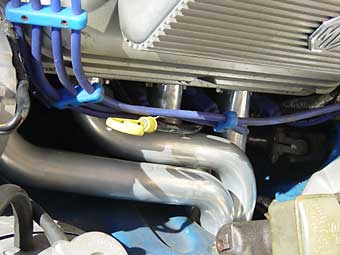 |
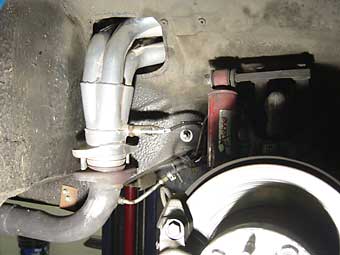 |
|
Driver-side header |
Passenger-side header & oxygen sensor |
Fabricating headers was the most time consuming and skill-intensive part of our engine
swap. We purchased a Hedman header kit or "box of bends" for the Ford 5.0 (with 1 5/8"
tubing). It had both left and right flanges and enough angles to complete our set with
some left over. We also used 3" Flowmaster ball-flange collectors from Summit. The end
results are good. The headers fit and work, plus we can change all spark plugs without
any difficulty - but it wasn't cheap! Our total cost (not including labor) was in excess
of $800 with more than 55 hours of our own fabrication work.
There are now cost effective headers specifically made for Ford-MGB engine conversions, in both thru-the-fender and block-hugger configurations, and you'll want to consider them.
Whatever headers you select, the EFI ECM requires oxygen sensors (two: one per cylinder bank) in the exhaust stream. We welded O2 sensor bungs onto the headers after some careful measuring to make sure the sensors wouldn't be damaged by the wheels at full wheel lock.
Finally, we sent our completed headers to Jet-Hot for application of their ceramic coating which provides durable corrosion protection and also performance benefits (because it helps keep heat inside the pipes). They provided very quick service. Suggestion: prior to coating, have the flanges trued or milled flat to prevent leaks later.
Ford EFI typically sits taller than a carburetor. A cowl type hood scoop or MGB-style bulged hood will likely be required, unless you're prepared to fabricate a special low-profile "spider" type intake manifold. The MGC-style hood I selected is fiberglass, and was provided by "Team Liebre" in Pennsylvania. (Editor's note: this model of hand-laid fiberglass MGC-style hood is no longer available from Team Liebre, but it is available from Tim Nagy at morSpeed Performance Products.)
Engine Specifications:
5.0 EFI Mustang, X-303 FPP heads, GT-40 Ford intake, 24lb. Ford injectors (in lieu of stock 19lb injectors), 65mm throttle body, PMAS 75mm mass air sensor, Comp Cam XE-264-HR-14 roller cam (could use more cam, but torque is great!), Ford Explorer timing cover, water pump, and harmonic balancer. Baseline dynamometer test: 266 RWHP & 298 Torque@ 4800rpm.
Disclaimer: This page was researched and written by Kelly Stevenson. Views expressed are those of the author, and are provided without warrantee or guarantee. Apply at your own risk.
There are now cost effective headers specifically made for Ford-MGB engine conversions, in both thru-the-fender and block-hugger configurations, and you'll want to consider them.
Whatever headers you select, the EFI ECM requires oxygen sensors (two: one per cylinder bank) in the exhaust stream. We welded O2 sensor bungs onto the headers after some careful measuring to make sure the sensors wouldn't be damaged by the wheels at full wheel lock.
Finally, we sent our completed headers to Jet-Hot for application of their ceramic coating which provides durable corrosion protection and also performance benefits (because it helps keep heat inside the pipes). They provided very quick service. Suggestion: prior to coating, have the flanges trued or milled flat to prevent leaks later.
Ford EFI typically sits taller than a carburetor. A cowl type hood scoop or MGB-style bulged hood will likely be required, unless you're prepared to fabricate a special low-profile "spider" type intake manifold. The MGC-style hood I selected is fiberglass, and was provided by "Team Liebre" in Pennsylvania. (Editor's note: this model of hand-laid fiberglass MGC-style hood is no longer available from Team Liebre, but it is available from Tim Nagy at morSpeed Performance Products.)
Engine Specifications:
5.0 EFI Mustang, X-303 FPP heads, GT-40 Ford intake, 24lb. Ford injectors (in lieu of stock 19lb injectors), 65mm throttle body, PMAS 75mm mass air sensor, Comp Cam XE-264-HR-14 roller cam (could use more cam, but torque is great!), Ford Explorer timing cover, water pump, and harmonic balancer. Baseline dynamometer test: 266 RWHP & 298 Torque@ 4800rpm.
Disclaimer: This page was researched and written by Kelly Stevenson. Views expressed are those of the author, and are provided without warrantee or guarantee. Apply at your own risk.


